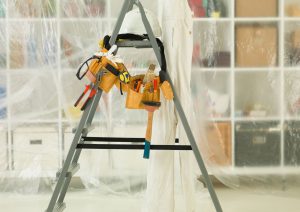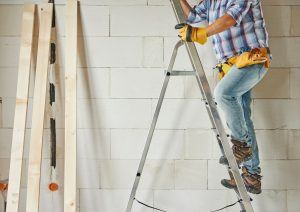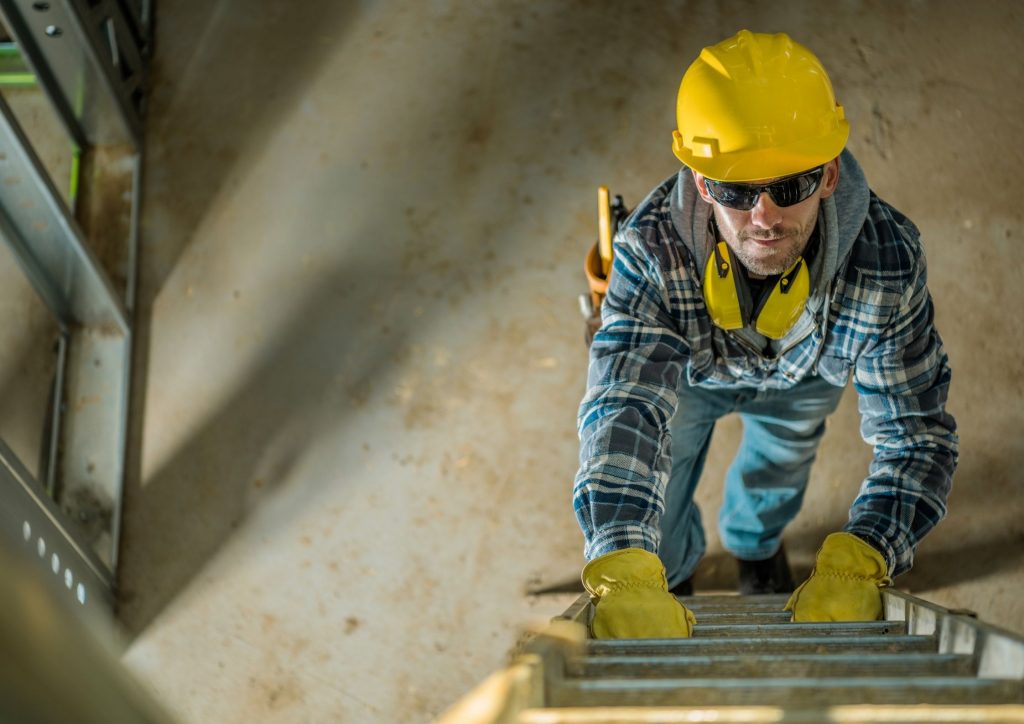The Occupational Safety and Health Administration has a lot of rules and guidelines employers, and employees must follow when it comes to ladder use. They are extremely important in ensuring the safety of anyone who is using a ladder to avoid any accidents or injuries. In this article, we will be going into more detail about the OSHA standard for ladders and what rules should be adhered to when using them.

Rules for all ladders
The rules below are applicable to all types of ladders:
- Maintain your ladders and keep them free of oil, grease, and any other potential slipping hazards.
- Don’t load ladders beyond their maximum intended capacity or over the manufacturer’s rated load.
- Only use ladders for their designed purpose.
- Only use ladders on stable and level surfaces unless they are suitably secured to avoid accidental movement.
- Don’t use ladders on slippery surfaces unless they have been secured or given slip-resistant feet to stop accidental movement. Never use slip-resistant feet as a replacement for taking care when placing, lashing, or holding a ladder on slippery surfaces.
- Secure ladders situated in areas like doorways, or driveways, or where workplace activities or traffic could cause unintentional movement. Alternatively, use a blockade to keep traffic or activity away from the ladder.
- Keep areas around the top and bottom of ladders clear.
- Never move, shift, or extend ladders while they are in use.
- Use ladders that are equipped with non conductive side rails if the worker or the ladder could come into contact with exposed energised electrical equipment.
- Always face the ladder when moving up or down it.
- Use at least one hand to grab and hold the ladder when climbing.
- Don’t carry loads or objects that could cause a loss of balance and fall from the ladder.
Specific types of ladders
- Don’t use single-rail ladders.
- Use any non-self-supporting ladders at an angle where the horizontal distance from the top support to the foot of the ladder is around one-quarter of the working length of the ladder.
- Use wooden ladders built at the job site with spliced side rails at an angle where the horizontal distance is one-eighth of the working length of the ladder.
Also, the top of a non-self-supporting ladder needs to be placed with two rails supported equally unless it has a single support attachment.

Stepladders
- Never use the top or top step of a stepladder as a step.
- Don’t use cross-bracing on the rear section of step ladders for climbing unless the ladders are designed and provided with steps for climbing on both front and rear sections.
- Step ladders should have a metal spreader or locking device to help ensure the front and back sections are kept open when the ladders are in use.
Portable ladders
At least 11.5 inches (29cm) of clear distance needs to be left between the side rails for any portable ladder. As well as this, the rungs and steps of portable metal ladders should be dimpled and covered with skid-resistant material or treated to minimise the risk of slipping.
Non-self-supporting and self-supporting portable ladders have to support at least four times the maximum intended load, extra-heavy-duty type 1A metal or plastic ladders should sustain 3.3 times the maximum intended capacity. In order to know whether a ladder that is self-supporting can hold a specific load, apply the weight to the ladder in a straight down vertical direction with the ladder put at an angle of 75.5 degrees.
In cases where portable ladders are used for access to an upper landing surface, the side rails need to extend at least 3 feet above the upper landing surface. When an extension like this is not possible, the ladder should be secured and a grasping device like a grab rail must be given to help workers with mounting and dismounting the ladder. A ladder extension must not deflect under a load that would lead to the ladder slipping off its supports.

Fixed ladders
If the overall length of the climb on a fixed ladder is equal to or exceeds 24 feet (7.3m), the ladder should be equipped with safety devices or self-retracting lifelines and rest platforms at intervals not to go over 150 feet (45.7m) or a cage or well and several ladder sections with each ladder section not to exceed 50 feet (15.2m) in length. These sections need to be offset from adjacent sections and landing platforms should be provided at maximum intervals of 50 feet. Also, fixed ladders have to meet the below requirements:
- They need to be able to support a minimum of two loads of 250 pounds (114kg) each, concentrated between any two consecutive attachments. Fixed ladders also need to support added anticipated loads that are caused by ice build-up, winds, rigging, and impact loads resulting from using ladder safety devices.
- Individual rung/step ladders should extend at least 42 inches (1.1m) above an access level or landing platform either by a continuation of the rung spacings as horizontal grab bars or by offering vertical grab bars that have the same lateral spacing as the vertical legs of the ladder rails.
- Every step or rung of a fixed ladder has to be able to support a load of at least 250 pounds (114kg) applied in the middle of the step or rung.
- Minimum clear distance between the sides of individual rung/step ladders and between the side rails of other fixed ladders have to be 16 inches (41cm).
- Rungs of individual rung/step ladders need to be shaped to prevent slipping off the end of the rungs.
- Fixed ladders without cages or wells should have at least a 15-inch (38cm) clearance width to the nearest permanent object on each side of the centreline of the ladder.
- Fixed ladders need to be provided with cages, wells, ladder safety devices, or self-retracting lifelines where the length of climb is below 24 feet (7.3m) but the top of the ladder is at a greater distance than 24 feet (7.3m) above lower levels.
Find your ideal ladder at BPS Access Solutions today.
No related posts.



